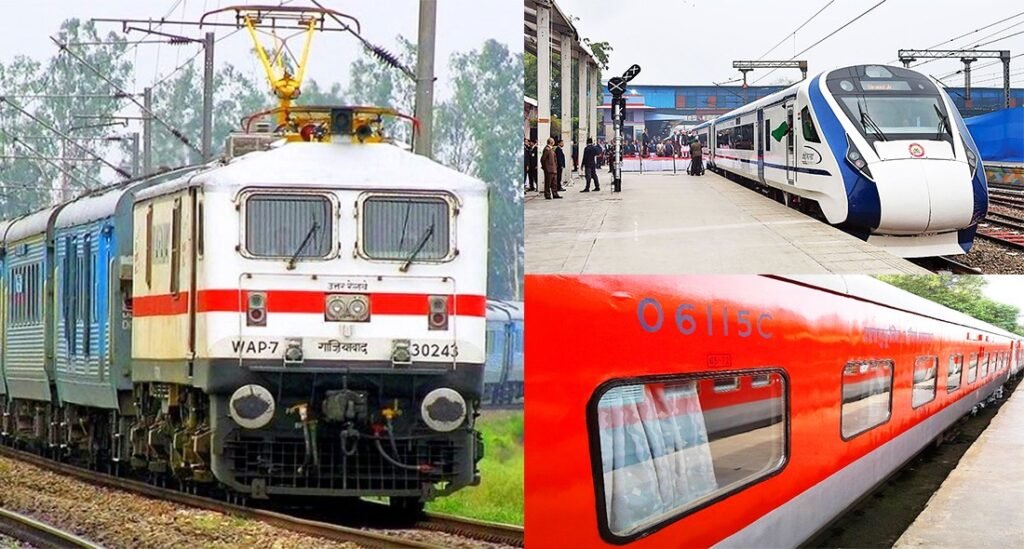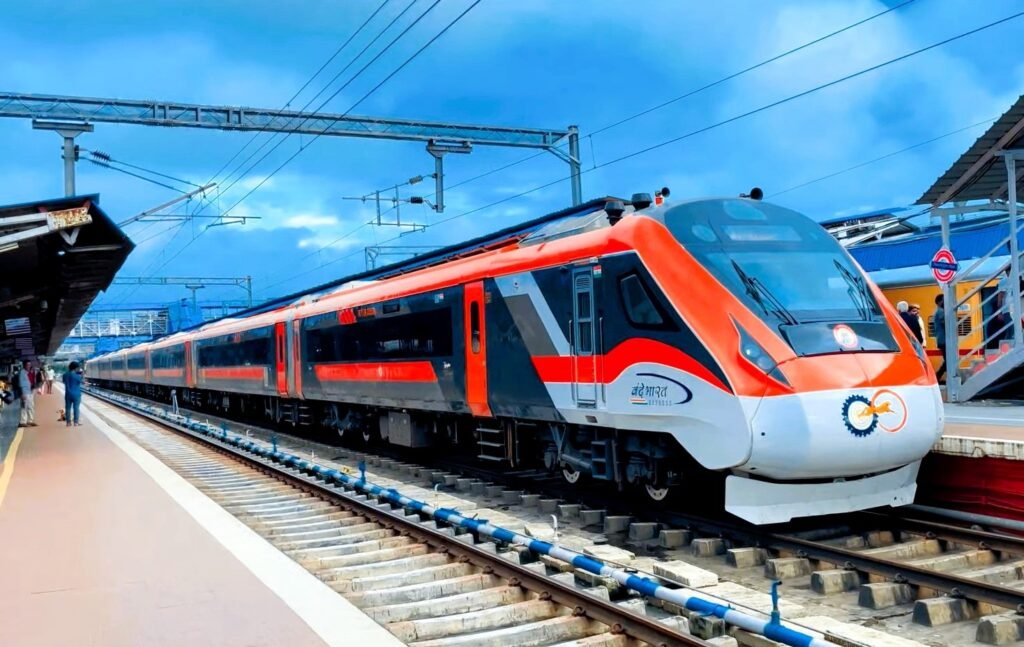India’s journey into high-speed rail began in the 1960s, driven by visionaries and fueled by growing demands for efficiency, speed, and luxury.
- The 1969 debut of the Rajdhani Express marked a new chapter, reducing journey times and introducing air-conditioned travel and onboard meals.
- Shatabdi Express followed in 1988, exemplifying comfort and speed across intercity routes.
- The 21st century has witnessed the rise of semi-high-speed trains, which combine modern design, high safety standards, and world-class amenities.
List: Top 10 Fastest Trains in India (2025)
Here’s a comprehensive look at the top 10 fastest trains, their routes, speeds, key features, and unique value:
Key Details of fastest trains:
| Name | Top Speed (km/h) | Key Route(s) | Major Stops | Typical Travel Time | Fare Range* (₹) | Key Features |
|---|---|---|---|---|---|---|
| Vande Bharat Express | 180 | Delhi–Varanasi, Mumbai–Ahmedabad | Kanpur, Allahabad, Surat | 8 hr (Delhi-VNS), 6hr 20min (Mumbai-Gandhinagar) | 1450–3000 | Modern AC, self-propulsion, Wi-Fi |
| Gatimaan Express | 160 | Delhi–Jhansi | Agra, Gwalior | 4 hr 25 min | 1125–1600 | Semi-high speed, Wi-Fi, catering |
| Tejas Express | 160 | Mumbai–Goa, Delhi–Lucknow | Panvel, Chiplun, Kanpur | 8 hr (Mumbai-Goa) | 1200–2200 | Onboard entertainment, smart features |
| Bhopal Shatabdi | 150 | Delhi–Bhopal | Agra, Jhansi, Bhopal | 7 hr 55 min | 1350–2000 | Speed, luxury, premium AC meal service |
| Rajdhani Express | 140 | Delhi–Mumbai, Delhi–Kolkata | Multiple metros | 15–17 hr | 2000–3500 | Premium, overnight, meals included |
| Humsafar Express | 130 | Various (Delhi–Bangalore etc.) | Varies | 10–36 hr | 1100–3000 | Modern 3-tier AC, CCTV |
| Double Decker Express | 130 | Mumbai–Ahmedabad, Bangalore–Chennai | Surat, Vadodara, Salem | 7-8 hr | 700–1600 | Two-level AC coaches, high capacity |
| Duronto Express | 130 | Delhi–Sealdah, Mumbai–Nagpur | Limited halts | 16 hr (Delhi-Kolkata) | 1800–3200 | Non-stop, premium, meal service |
| Kavi Guru Express | 130 | Howrah–Porbandar | Rajkot, Ahmedabad | ~40 hr | 2000–3800 | Connects key cities, fast intercity |
| Uday Express | 130 | Bangalore–Coimbatore | Salem, Erode | 7 hr 30 min | 800–1300 | AC double-decker, intercity commuter |
*Fare ranges may vary by train class (Chair Car, Executive Class, etc.), time of booking, and promotional campaigns.
Key Routes and Major Locations
The fastest trains in India operate within a network that connects major cities, commercial hubs, and emerging economic corridors.
- New Delhi–Varanasi (Vande Bharat): Exemplary semi-high-speed route, reducing travel time to around 8 hours.
- Delhi–Jhansi (Gatimaan): Takes only 100 minutes between Delhi and Agra extension.
- Mumbai–Goa (Tejas): Known for stunning coastal views, speed, and superior onboard services.
- Delhi–Bhopal (Shatabdi): Connects two administrative and commercial giants at 150 km/h.
These key routes facilitate regional transformation, economic growth, and enhanced mobility.
Features of India’s Fastest Trains
Today’s fastest trains boast innovations in technology and comfort, rivalling international standards.
- Modern Coaches: Ergonomically designed seats, spacious interiors, automatic doors, and large windows.
- Smart Amenities: Wi-Fi, infotainment, mobile charging ports, GPS-based information screens, and personal TV screens in select classes.
- Safety and Security: CCTV surveillance, advanced signalling, and anti-collision technology.
- Onboard Services: Gourmet meals, beverage counters, and eco-friendly practices.
- Green Technology: Electric propulsion reduces carbon footprint, making these trains an eco-conscious alternative to road and air travel.
Cost of Travelling: High-Speed Fares Explained
Ticket costs for India’s fastest trains vary based on distance, class, and amenities.
- Short routes: Fares start around ₹1,000 (e.g., Surat–Vadodara, within the Mumbai–Ahmedabad corridor).
- Medium routes: Generally ₹1,800–₹2,500 for standard class, with executive classes higher.
- Long routes: For example, the Delhi–Varanasi Vande Bharat fares range from ₹3,000 to ₹3,500 for premium classes.
- Tejas Express: Fares are competitive with air travel but come with added luxury and entertainment.
- Subsidised tickets for the economically weaker sections and children reflect inclusive pricing.
The Technology Behind India’s Fastest Trains
India leverages the global fastest trains technology, seamlessly merging Japanese Shinkansen systems, indigenous engineering, and digital automation.
- Self-propelled train sets, such as the Vande Bharat and Tejas trains, operate without traditional locomotives, utilising distributed motors for enhanced efficiency.
- Aerodynamic Design: Reduces drag and increases stability at high speeds.
- Signalling: Trains operate on automatic signalling, ensuring safety at speeds exceeding 160 km/h.
- Dedicated Corridors: Projects like Mumbai–Ahmedabad are building tracks designed for speeds up to 350 km/h, using earthquake-resistant infrastructure.

History of High-Speed Rail in India
The roots date back to 1969 with the Rajdhani Express, followed by the Shatabdi from 1988, culminating in 2019’s Vande Bharat, the first indigenously built fast train capable of running at 180 km/h. The government’s 2025 vision focuses on bullet trains and nationwide corridors.
- First passenger train: Bombay–Thane (1853), covered 34 miles at 57 km/h.
- Electric traction: Introduced in Bombay, 1925, enhancing speed possibilities.
- Diesel and steam evolution: Improved reliability and efficiency in the 1950s–1970s.
- Modern era shifts: The last few decades have seen speed increase, comfort enhance, and safety become paramount.
Socio-Economic Impact
Fast trains have changed the dynamics of Indian travel, making business, education, and tourism more reachable and boosting local economies.
- Urban-Suburban integration: Enhanced access to jobs, education, and services.
- Tourism growth: Stretches like Delhi–Agra and Mumbai–Goa attract both domestic and international tourists.
- Reduction in Journey Time: Trips that previously took 12 hours now take as little as 3 hours with the introduction of planned ultra-fast corridors.
Recent News
Vande Bharat Express Sets New Record – India’s Fast Trains Transform Long-Distance Travel with Speeds of 180 km/h, Cutting Journey Time and Boosting Comfort in 2025
India has reimagined its railways with the introduction of ultra-fast trains, including the Vande Bharat Express, Gatimaan Express, and Tejas Express. As corridors dedicated to trains travelling at speeds of 320–350 km/h near completion, the rail network is set to dramatically reduce travel times. These advanced trains embody a blend of luxury, speed, and technology, preparing the country for a new era in public transportation.
FAQs About Fastest Trains in India
What is the fastest train in India as of 2025?
The fastest train is the Vande Bharat Express, which operates at speeds of up to 180 km/h on select routes.
Which route has the shortest travel time among the top trains?
The Delhi–Agra stretch via Gatimaan Express completes its journey in just around 100 minutes, having one of the best speed-to-distance ratios.
What amenities are available on fast trains like Vande Bharat and Tejas?
Amenities include smart seating, Wi-Fi, infotainment, CCTV for safety, onboard gourmet meals, and modern restrooms in all classes.
Are fares for the fastest trains comparable to those for air travel?
Yes, premium trains like Tejas and Vande Bharat have fares similar to those of low-cost airlines, but they provide greater comfort and less hassle.
How does high-speed rail promote environmental sustainability?
High-speed trains are fully electric and reduce carbon emissions compared to cars and flights, thanks to advanced rail infrastructure and minimal reliance on fossil fuels.
Is the high-speed train network expanding beyond major metros?
Yes, India’s 2025 vision targets routes like Mumbai–Ahmedabad and Delhi–Varanasi, while plans for pan-India bullet-train corridors are underway.
What is the future of high-speed rail in India?
The government is investing in faster, safer trains and dedicated tracks, aiming to connect India’s largest cities under three hours via new high-speed corridors.

